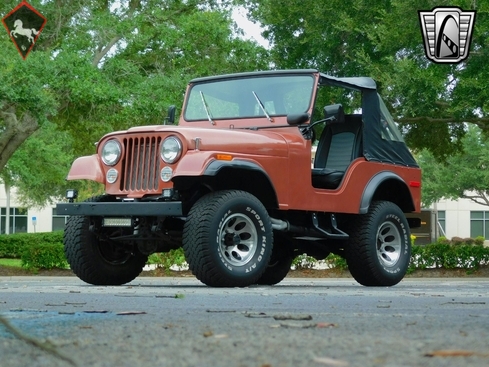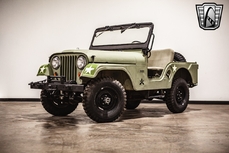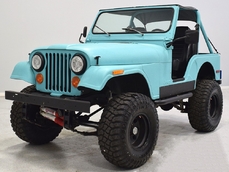Jeep CJ5 304 V8 1974
General description :
Mileage : 62167
Interior Color : Black/Silver
Exterior Color : Burnt Orange
VIN : J4F835TH51267
Transmission Description : 3-Speed Manual
Doors : 2
Description : Gateway Classic Cars of Orlando is proud to present this 1974 Jeep CJ5, a classic off-road vehicle that combines power, style, and comfort. This model comes in a striking burnt orange exterior color that is sure to turn heads wherever you go. The bold color is not only aesthetically pleasing but also adds a unique touch to this classic Jeep model.
Under the hood, you'll find a 304 V8 engine, which is renowned for its performance and power. This engine, coupled with a 3-Speed manual transmission, ensures a smooth and engaging driving experience. Whether you're navigating city streets or exploring off-road trails, this Jeep CJ5 is designed to handle it all with ease.
Inside, the Jeep CJ5 boasts a black and silver cloth interior that complements the burnt orange exterior. The seats are not only comfortable but also durable, designed to withstand the rigors of both everyday use and off-road adventures.
In addition to the cloth seats, the interior also features vinyl elements, which are easy to clean and maintain. This combination of cloth and vinyl materials adds a touch of sophistication to the interior, making it as stylish as it is practical.
In summary, this 1974 Jeep CJ5 is a classic vehicle that offers a blend of power, style, and comfort. Its burnt orange exterior, powerful 304 V8 engine, and comfortable cloth and vinyl interior make it a standout choice for any classic car enthusiast.
https://www.gatewayclassiccars.com/vehicle/ord/2458/1974-jeep-cj5
1974 Jeep CJ5 304 V8 is listed sold on ClassicDigest in Lake Mary by Gateway Classic Cars for $19000.
Car Facts
Car type : Car Make : Jeep Model : CJ5 Model Version : 304 V8 Engine size : 0.0 Model Year : 1974 Location : Orlando
Sold
Seller Information
Sold
People who viewed this Jeep CJ5 also viewed similar Jeep listed at ClassicDigest
Other cars listed for sale by this dealer
About Jeep
The history of Jeep is a tale of rugged innovation and an iconic journey from its roots as a military workhorse to its various civilian versions, including American competitors to the Range Rover.The Birth of the Jeep:
The Jeep story began during World War II when the U.S. Army put out a call for a small, versatile, four-wheel-drive vehicle. Several American automakers responded, but the Willys-Overland company, along with its partner Ford, ultimately won the contract. The result was the Willys MB, an agile and tough vehicle that quickly earned the nickname "Jeep." The name's origin is a subject of some debate, but it's believed to have been derived from the military phonetic alphabet's "GP" designation, which stood for "General Purpose" or "Government Purpose."
World War II Service:
Jeeps became the backbone of the American military, serving in various roles from reconnaissance to medical transport. Their durability, four-wheel-drive capability, and ease of maintenance made them invaluable during the war. They were used in all theaters of the conflict and left an indelible mark on military history.
Post-War Transition:
After World War II, many surplus military Jeeps found their way into civilian hands, and their utility became evident beyond the battlefield. Recognizing this potential, Willys-Overland began producing the CJ (Civilian Jeep) series, starting with the CJ-2A in 1945. These early civilian Jeeps retained their military roots but were adapted for farm, ranch, and off-road use. They soon gained popularity among outdoor enthusiasts and those in need of a rugged, capable vehicle.
The Jeep Brand Expands:
Over the decades, the Jeep brand continued to evolve, introducing a wide range of models to cater to different consumer needs. The Jeep Wagoneer, introduced in 1963, was one of the earliest luxury SUVs and a competitor to the Range Rover, offering four-wheel drive and a comfortable ride.
The Jeep Cherokee, introduced in 1974, was a pioneering compact SUV that combined off-road capability with on-road comfort. Its success laid the foundation for the modern SUV segment.
In 1984, Jeep introduced the Jeep Grand Cherokee, which further advanced the brand's presence in the luxury SUV market. The Grand Cherokee was designed to deliver a refined driving experience without sacrificing its off-road prowess.
Jeep Wrangler, which evolved from the CJ series, has remained a steadfast symbol of off-road capability and rugged adventure. The Wrangler has garnered a devoted following of enthusiasts who appreciate its simplicity and go-anywhere attitude.
Jeep Renegade, Jeep Compass, and Jeep Gladiator are examples of modern Jeep models that cater to a wide range of consumer preferences and market segments.
American Competitors to the Range Rover:
While Jeep has produced various models to compete in the luxury SUV market, including the Grand Cherokee, they have also faced competition from American automakers like Cadillac and Lincoln, which have introduced their own luxury SUVs to compete with the Range Rover. These vehicles offer a blend of comfort, technology, and off-road capability, making them alternatives to the Range Rover for American consumers.
In conclusion, the history of Jeep is a story of adaptability and innovation, with the brand transitioning from its military origins to become a symbol of rugged individualism and adventure. Jeep's ability to blend off-road capability with on-road comfort has made it a respected and iconic American brand in the world of 4x4 vehicles.


























